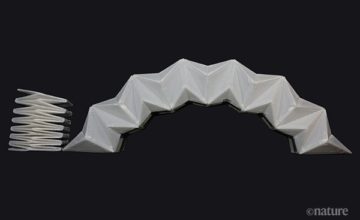Sigrid Adriaenssens in Nature:
 It might seem surprising that origami, the ancient Japanese art of paper folding, is an integral part of engineering. However, origami structures can be folded up compactly and deployed at the nano- and macroscales seemingly without effort. They are therefore well suited for a wide range of applications, including robotics1, arrays of solar panels2 and engineered structures known as metamaterials3. Writing in Nature, Melancon et al.4 report triangular origami facets that snap into 3D shapes when filled with a pressurized fluid. The authors’ work provides a new method for designing large origami enclosures that can be deployed and locked into shape through inflation.
It might seem surprising that origami, the ancient Japanese art of paper folding, is an integral part of engineering. However, origami structures can be folded up compactly and deployed at the nano- and macroscales seemingly without effort. They are therefore well suited for a wide range of applications, including robotics1, arrays of solar panels2 and engineered structures known as metamaterials3. Writing in Nature, Melancon et al.4 report triangular origami facets that snap into 3D shapes when filled with a pressurized fluid. The authors’ work provides a new method for designing large origami enclosures that can be deployed and locked into shape through inflation.
In engineering, a deployable structure is one that can change shape in a way that greatly alters its size — large-scale examples include scissor lifts and bouncy castles. Conventional deployable structures are transformed into a larger shape through the extension of linkages (as in scissor lifts) or by inflation (bouncy castles). Both types of structure are then secured into their new shape by an external agent: a lock and the sustained application of air pressure, respectively. However, neither can secure themselves.
More here.
